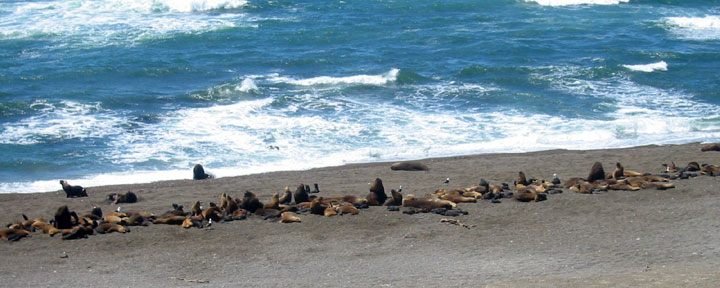February 21, 2005
Two Days in Uruguay
This will be an entry of mostly photos. I hope they work for all of you.
The photos are below. But you can press HERE to see a slideshow of photos for this and the previous entry.
We left mid-morning Tuesday - the 15th. We drove north on Route 9 and then Route 12. We only passed by one city of any size, Campana. The land is flat grassland and river bottoms. It is about 300 kilometers to Gualeguaychu, an average mid-sized town about 50 kilometers west of the first bridge that crosses the Uruguay River. The crossing was uneventful. They really go overboard on not allowing agricultural products like milk, cheese, meat and fruit to come across. The fruit is pretty typical but the rest is unusual for two friendly, nearly identical countries. So we ate our sandwiches before tossing what we could not eat and then entering Uruguay. It was another 200 kilometers before we made it to Colonia, which is just 50 kilometers by water. The drive was interesting, but the next time we will be taking the ferry, despite the cost.
Colonia del Sacramento is a small town. It has a fantastic beach on the river. In fact the river's beach has sand finer than the ocean. And it seems to stretch on forever. Compare this to the swamp on the Argentine side. A small part of the town still has a colonial feel. I am not saying that it is anything like Antigua in Guatemala. Still it is lovely and unusual for a part of the world that seems to be no more than 120 years old despite its 300 plus year history. Besides the normal cars and hundreds of motor scooters, I saw a good number of antique cars around. We found a nice place in the old part of town. It cost only $22 per night and as usual it included breakfast. There was a TV in the room. In the evening, I was disappointed to find that it did not work. We sat at a river front restaurant drinking beer and enjoying the sunset. After ole sol descended, we stopped at a nearby pizzeria for a pie and some more beer.
The Rio de la Plata's Beach in Colonia

On Wednesday we spent the morning exploring old town and especially its shops. Midday we grabbed some of the food we got through the border and had lunch. I guess we should have tossed it all, because the one piece of sausage we salvaged made me sick the next day - but that will come later. Then we drove to two nearby wineries, the Bernardi and Caluva wineries. The wine was not all that good, but I love the vintner culture. Vineyard owners and workers can be so wonderful. I really find most of them just so friendly and open. They make a lot of grappa here, too. It doesn't taste all that great either. After the wineries, we drove down by the beach. We rested and enjoyed the river as we drank beer.
Colonia 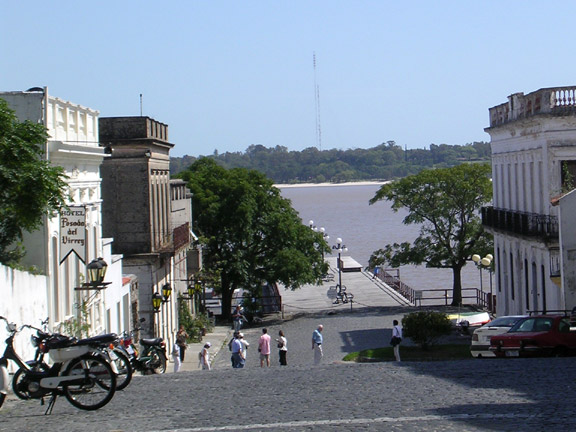 |
Old Town 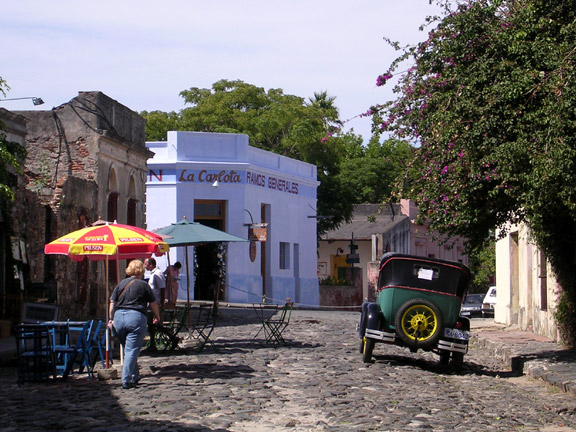 |
Old Cars 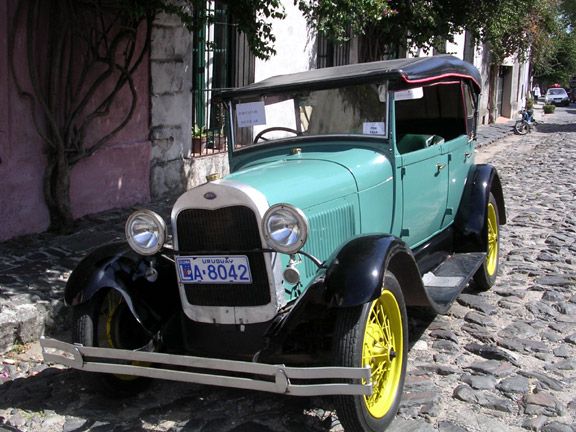 |
Pleasant Walks 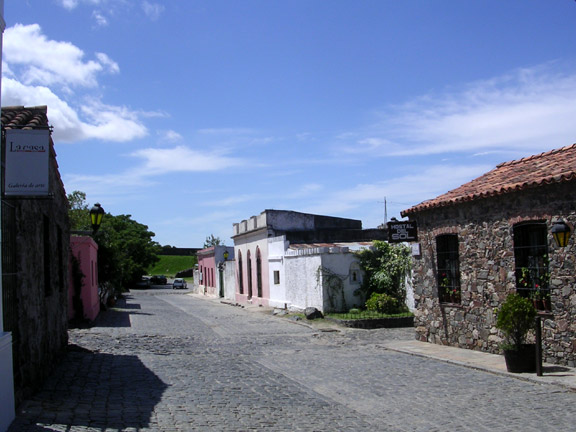 |
Past the Lighthouse 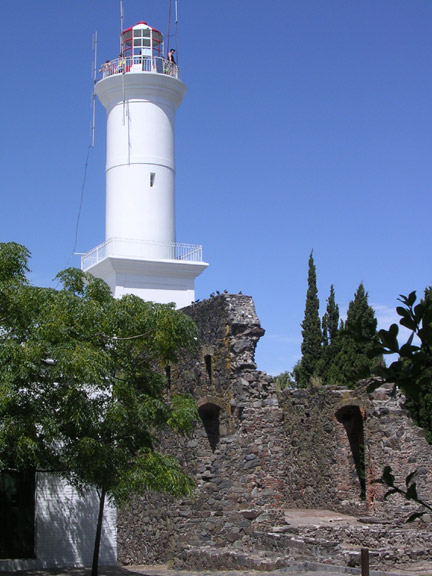 |
And Cobble Stone Streets 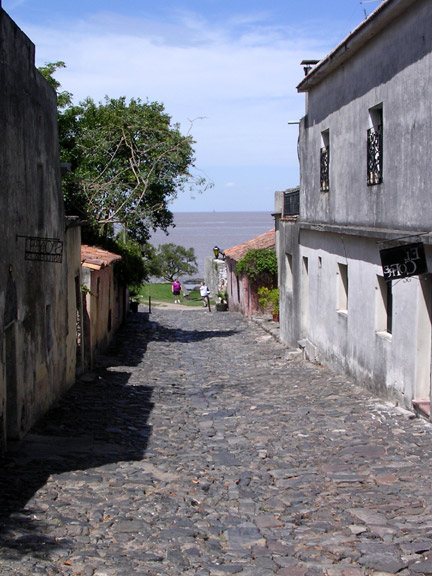 |
The Bernardi Winery 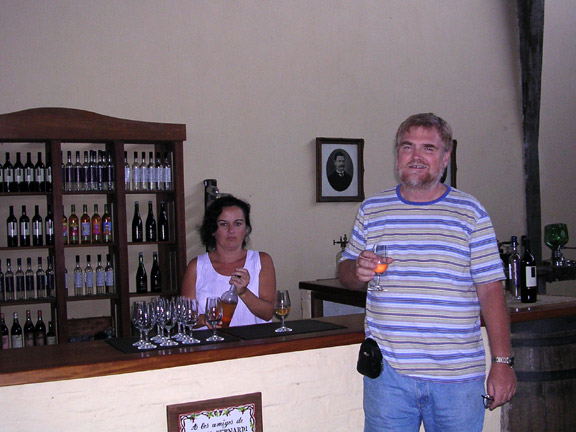 |
Wine in Wood Barrels 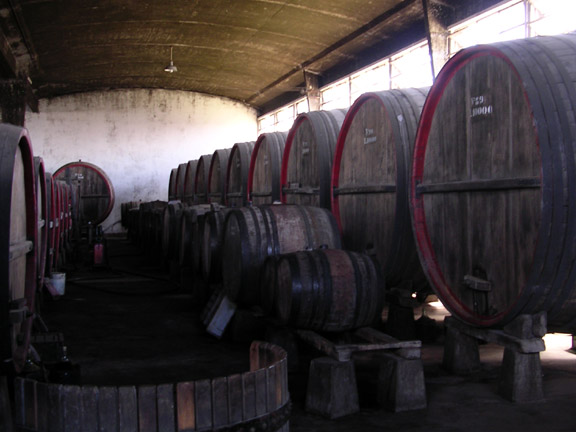 |
On Thursday we decided to drive to two wineries in nearby towns. One was supposed to produce a five-star wine. The first winery was not very welcoming to visitors. They wanted to be called and, I think, they wanted a fee. I never pay. So we were off. The other was the Irurtia Winery. I was beginning to feel the bad sausage from the day before and yet it was one of the nicest wineries that I have been to in a long time. They were just beginning the syrah harvest. We ate some. I was so surprised by how good the grapes tasted. We got to see the entire operation from the grapes being processed to the wine cave. We tried a fantastic sweet white wine. We did not buy that expensive one, but bought three others.
We returned to a park in Colonia. Our ferry would leave in just a couple of hours. The slow ferry takes 3 hours for the 30 mile river and costs for than twice the fast, one-hour, boat. Still is cost more than $70 and another $20 departure tax. I am surprised that so many people make the journey everyday given the cost. Still there is more than half-a-dozen crossings everyday. We arrived about 10:30 at night. It was good to be back in our Argentine home.
Entrance to Irurtia 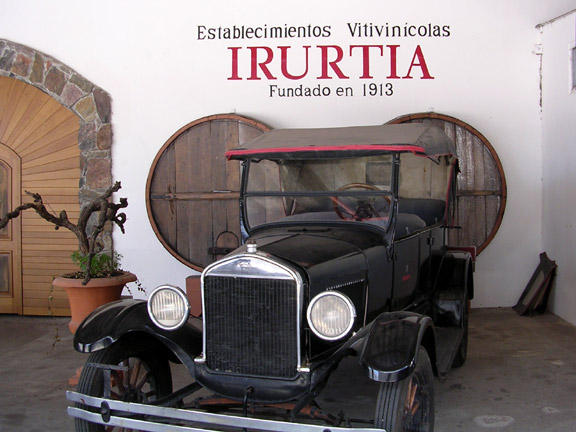 |
Processing the Syrah 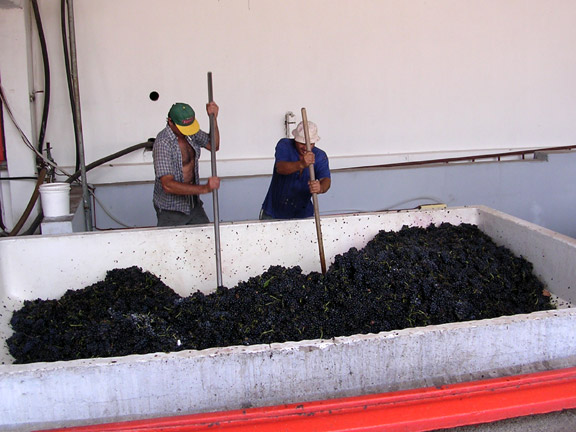 |
Picking the Muscat Grapes 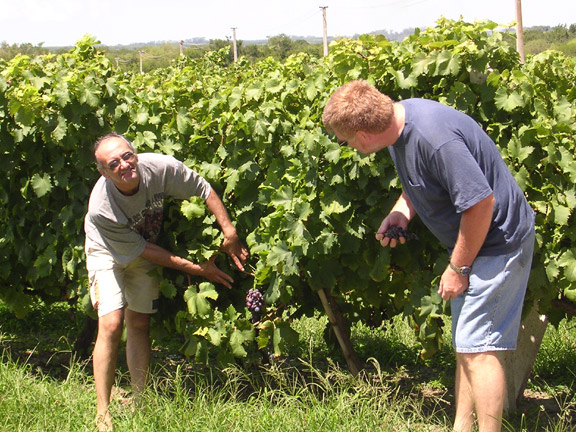 |
Enjoying the Wines 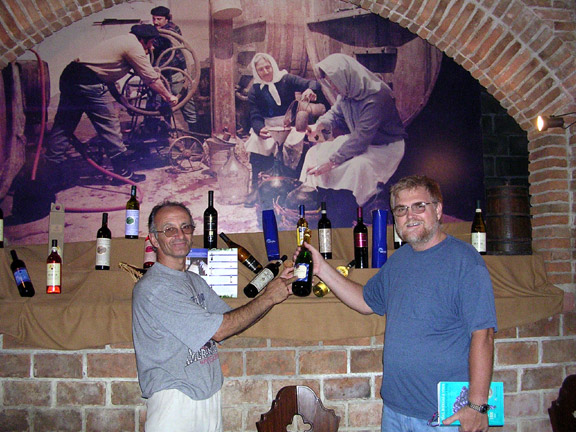 |
I was pretty much out of it the next day. Thank god for ciprofloxacin hydrochloride, or just a cipro. Take six 500 mg. tablets over three days, and all is well.
February 14, 2005
The Simonsen's Visit
Bent and Kurt
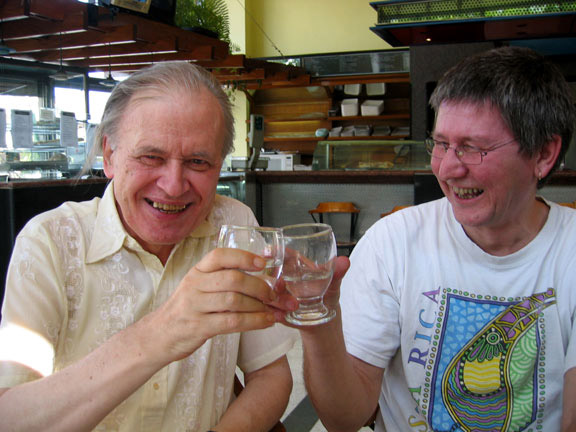
Press
HERE to see a slideshow of photos
for this and the next entry.
Kurt and Ulla Simonsen came to Buenos Aires last Tuesday, the 8th of February. Kurt is a journalist that works for the Danish tabloid, Ekstra Bladet. Ulla is a school teacher. I picked them up at the airport in the morning. We got back to our house. They took a short walk through the neighborhood, and then took a nap. They had been traveling for about 20 hours before getting here. In the evening we when out to a restaurant in Puerto Madera. It was a big buffet. The food was good and we enjoyed the evening out.
On Wednesday Kurt and Ulla took a cab downtown late in the morning. Then they headed to the suburb of Martinez, so that Kurt could meet with the Danish chess grand-master, Bent Larsen. Larsen was in contention for the world championship in the 70's - but Fisher beat him out for the right to challenge Spassky. I got a chance to meet this brilliant old man, when I picked up Ulla and Kurt late in the afternoon. From what I saw when I met Bent and from some of the stories Kurt told me, Bent is a hell of an interesting person to know. I drove them around some of the northern suburbs, like Tigre. A strong storm front blew in while were driving. We saw several trees down from the winds. Kurt and I stopped to pull one tree out of the road. We ate at a neighborhood restaurant, when we finally got back to our house.
At Evita's Tomb 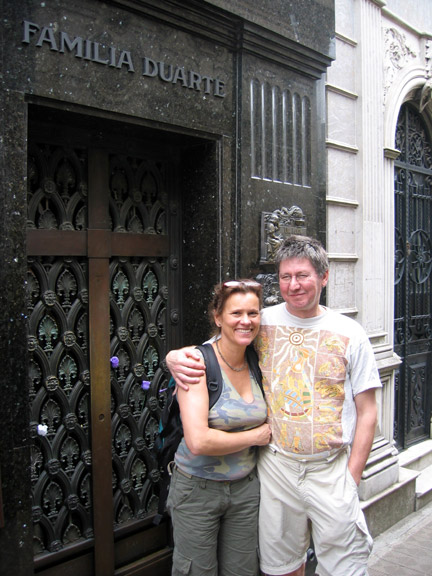 |
In Recoleta 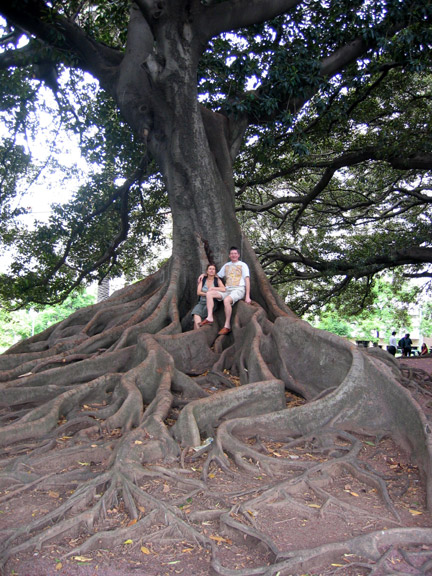 |
Turistas en La Boca 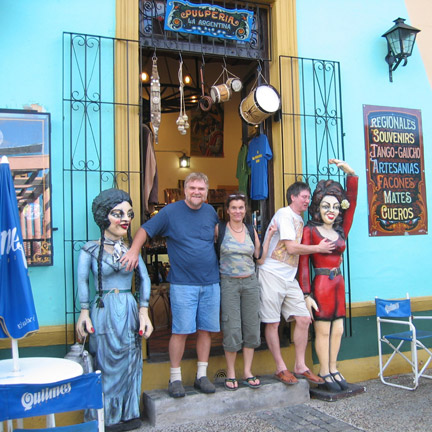 |
On Thursday we drove to several of the sites that so many first-time visitors see when they come to Buenos Aires. We visited the cemetery in Recoleta and saw the tomb of Evita Peron. Then we drove to San Telmo for a quick tour of the antique shops. We took a bus down to the Plaza del Mayo in front of the president's residence, Casa Rosada. Here, every Thursday, the Mothers-of-the-Disappeared gather at 3:30 in the afternoon. It was quite a site to see them still marching for their loved ones twenty plus years. I was deeply moved. The government disappeared some 30,000 people in the 70's and 80's. I suppose that Henry Kissinger had a hand in it, just like he did in Chile. They ought to try him for crimes against humanity. We returned to San Telmo to get the car. Then we headed over to La Boca. They really liked that neighborhood. Unfortunately, they did not have time to visit the museum. Thankfully, they got to see Tango dancers on the street. God, were they good! We finally got back to the house about 7:00. Ulla took a nap. At 9:00 we went to my favorite Tango social club on Armenia Street. They really liked it. They both got their first Tango lesson. Betty was dancing too. We got back about midnight. It had been a long, but very enjoyable day.
Mothers of the Disappeared
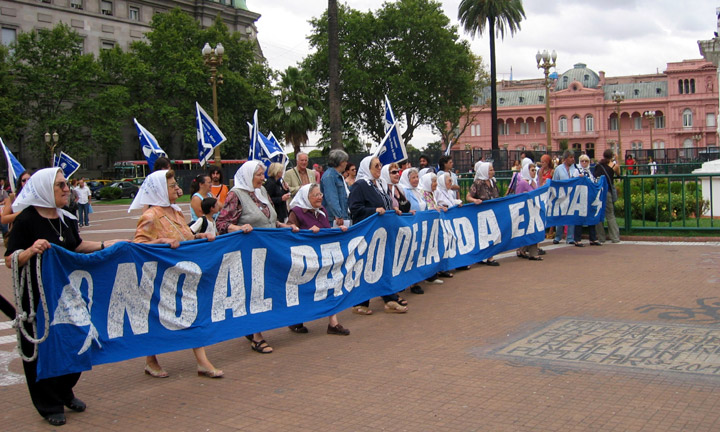
In La Boca 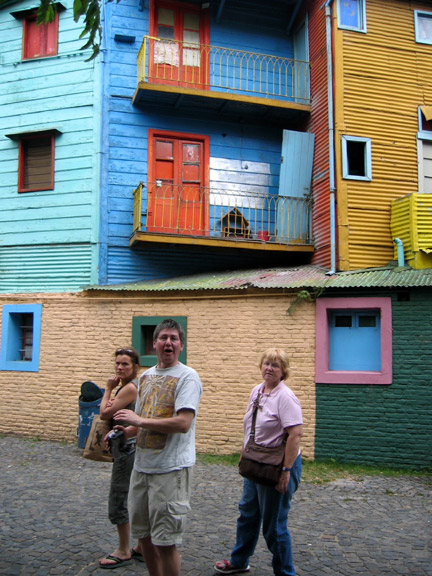 |
Dancers in the Street 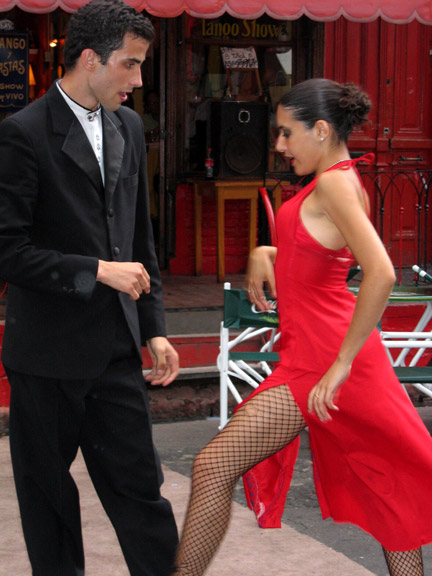 |
Dancing in the Evening 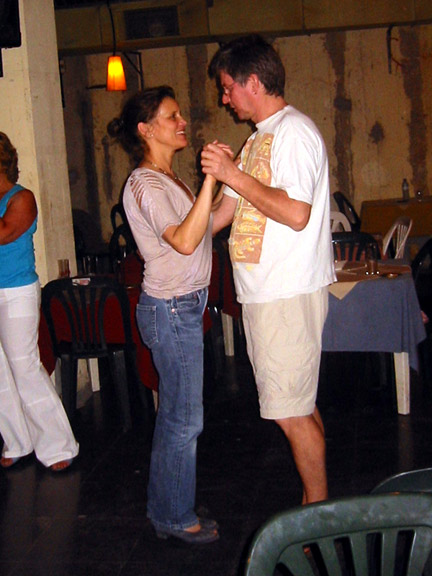 |
We drove them to the airport the next day. They were headed for Iguazu for a couple of days before heading to Mendoza. I hope they have a good time.
On Saturday we went out for Chinese New Year. Boy, is the Chinese different here: no peanuts or hot peppers in the Kung Pao beef; no rice automatically served with the meal; and no fortune cookies to be found in the restaurant! Still, it was a nice change.
Yesterday, we checked out their nicest mall on the north side of the city, the Unicenter. We saw Hillary Swank's new movie, Million Dollar Baby. We liked it a lot and recommend it.
We hope to visit Uruguay in the next few days. We will let you know how that goes.
February 05, 2005
Patagonia
Betty and I decide to see a bit of Argentina.
We left Buenos Aires on the 22nd of January and returned on the First of February.
What follows is brief account at lots of photos.
If you want, you can press
HERE to see a slideshow of all our photos from Patagonia.
Saturday, 22nd of January:
We left Buenos Aires about midday. It had been raining lightly off-and-on in the morning. We headed west Route 5 and drove the rest of the day until we reached Santa Rosa. The first thirty miles was a good four-lane toll-road. I don"t mind too much paying for a good toll-road if the cost is reasonable. The tolls were not too high in North American terms but for the Argentineans, I have to believe that they are onerous. Of course they have no idea what it is like in Europe or the USA, so they have no point of comparison. In general, the federal roads within 300 miles of Buenos Aires are toll-roads. The problem is that they usually are not good four-lane roads. In fact they are dangerous for the heavy traffic and poor designs of the pavements, which are occasionally rutted like in Mexico and seldom in excellent repair. I would just as soon avoid these roads, but there are very few alternative provincial roads.
The countryside in this part of Argentina is beautiful to me, because I am a boy of the Midwest. Here there was pasture land and some crops. They do not seem to tile the land here and so there are many wetlands that team with wildlife and many birds, like ducks, swans, hawks and Chilean flamingos. I do not believe there is any large wildlife here, no bears or deer. The hare is pretty common as is the South American armadillo. There are some other large rodents and mountain lions. We eventually saw a large rodent, but I don"t know what they are called. The land is very flat here and this is another way that it reminds me of the Great Plaines. We rolled into Santa Rosa at just about sundown and got a hotel room for about $25 USD. As far as hotel costs go the range was $18 to $35 with most about $28 USD.
Lake Lácar  |
Lanín National Park  |
With María and Marisol
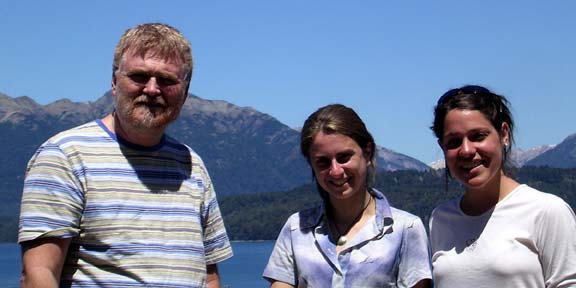
Bill and Todd
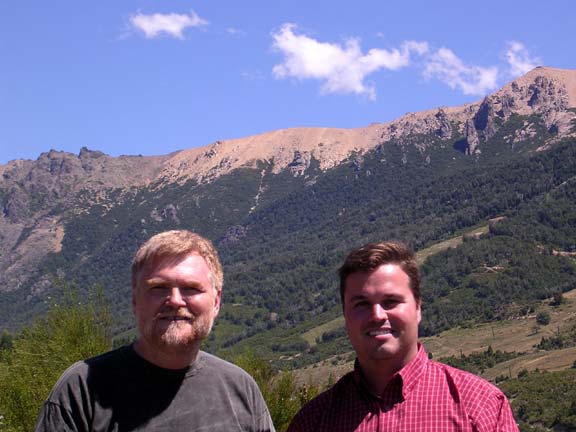
Sunday and Monday:
We did not explore Santa Rosa we just drove on. The terrain changes fairly quickly after we left. There were light rolling hills and, of course, the desert. We were now in or approaching the Patagonian provinces. Patagonia stretches for more than one thousand miles and it is mostly a vast desert or mountains. This is like the deserts of the western USA or Mexico with lots of brush amid the sand, gravel and rock. We arrived at dusk in San Martin de los Andes. This is a lovely little tourist town. Betty compares it to Kamloops, British Columbia. Where that came from, was a trip we took to BC more than ten years ago. Since I cannot remember the place I have no idea how well she pegged it. Betty really liked this place a lot. It was pretty, not too expensive and had some great restaurants.
On Monday, we wanted to visit a nearby volcano, but we chickened out when the unpaved road turned out to be really rough. I should mention here that the majority of roads in Patagonia are unpaved. We returned to the town and then took a trail five miles back into the forest to great look out point. After that we went down to the harbor and to journey by boat to a nearby park. The boat was slow and the view was spectacular. On this evening we ate at La Tasca, probably the neatest and most unique restaurant in the town. The food was good. As usual the wines are inexpensive and so good, so tasty that I wonder why we are not becoming alcoholics.
Tuesday, Wednesday and Thursday:
We took the Lakes road to San Carlos de Bariloche, which is only paved for part of the way. We picked up two hitchhikers, María and Marisol, as we left San Martin. Hitchhiking is a common mode of transport here. Just the day before, we picked one up and brought them from Junin to San Martin. We picked up several more on this trip. Most were students on the summer holiday. The drive to Bariloche took about four hours. The forest and lakes are beautiful. We stopped along the way to enjoy the sites. When we dropped our riders off and had planned to meet them later in the evening. Unfortuately this never happened, I figure that they went to the other Irish pub in the town. In any case, we took a room at the Hosteria Ivalu. We explored the downtown area on foot, visiting the local tourist information office and eating lunch at the Pilgrim, one of the two pubs in town. After hiking around we rested in our room before heading out once again for beer and food.
The next day we took an extended trip through the area. We saw several lakes. We had lunch at an out of the way restaurant that brewed there own beer. We visited the Swiss Colony, a real disappointment. We drove to the Cathedral Mountain, but found the ride up was too expensive. One very good thing that happened was that we picked up an American hitchhiker, Todd Stevens. He is a 33 year old, who sold everything back in the States. He plans to buy land and start a vineyard near Mendoza. I"ve got to say that this sounded like a great idea. I think Argentina has many opportunities for such a business. With any luck we will see him again, when pass through the Mendoza region of Argentina. We ate at the Familia Weiss restaurant that evening. My only complaint was that they no longer had sauerkraut on the menu.
Bariloche Church 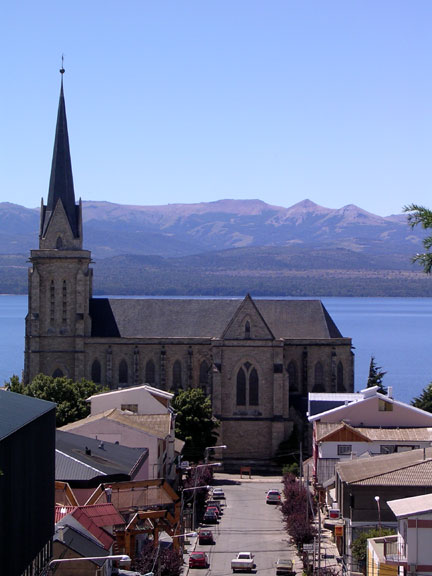 |
Lake Nahuel Huapi 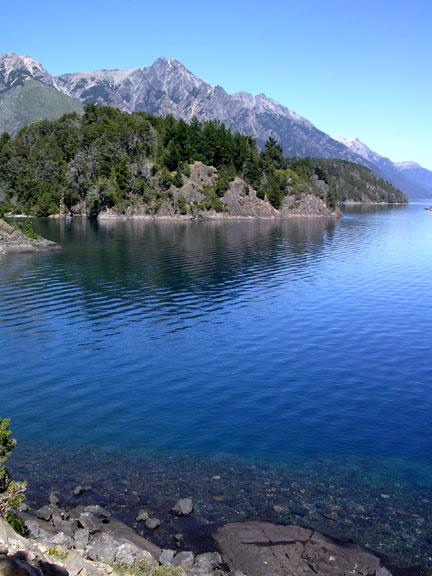 |
Nahuel Huapi Beach 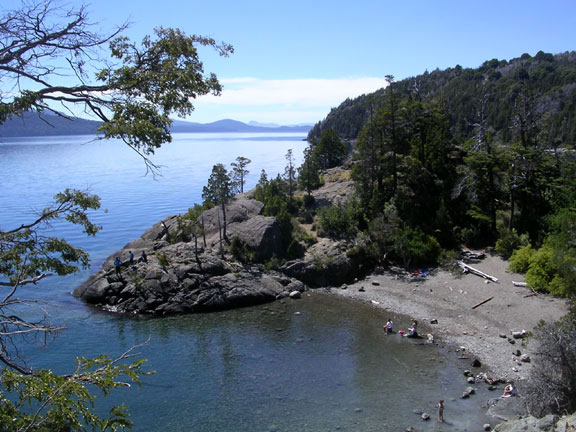 |
Looking Toward Chile 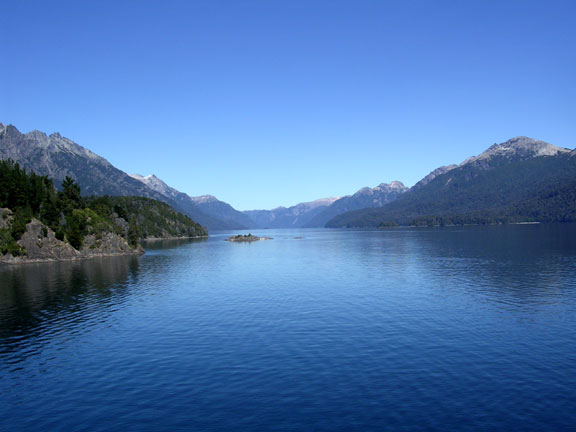 |
On Thursday, we visited El Bolson, cute little town about 90 minutes south of Bariloche. There was a fair in the park to celebrate the town"s 79th birthday. We bought several handicraft items and some jams and jellies. We also had a nice lunch with some of the local homemade craft beer. We took a break when we got back. Then we did some shopping for the local pottery. In the evening we went to a Mexican restaurant. I had eaten there three years ago and found the food to be just average, but this time it was good. It was some of the best Mexican food that I have had outside the USA and Mexico. What a pleasant surprise.
El Bolson Vendor 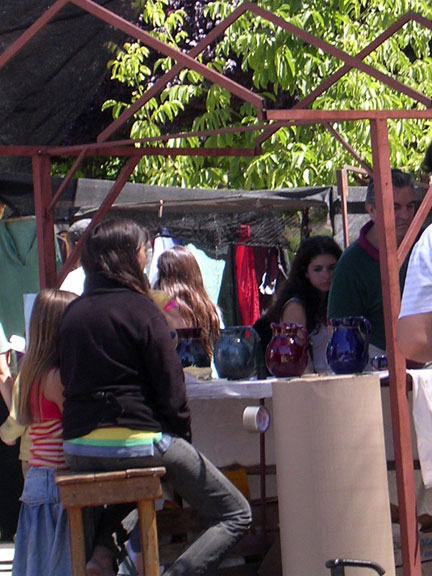 |
In the Market 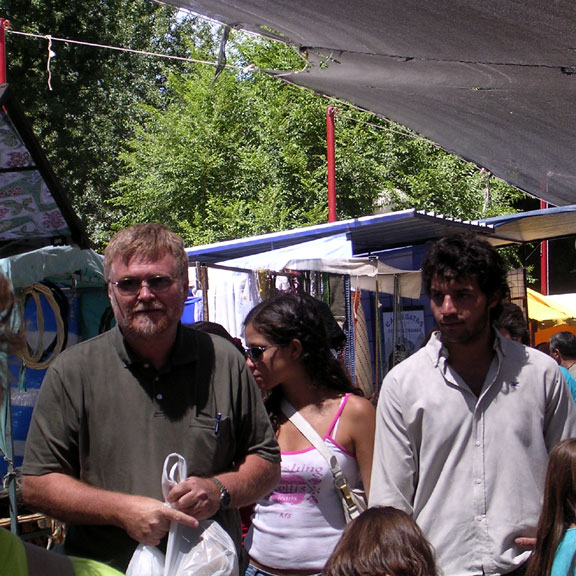 |
A Mime Prepares 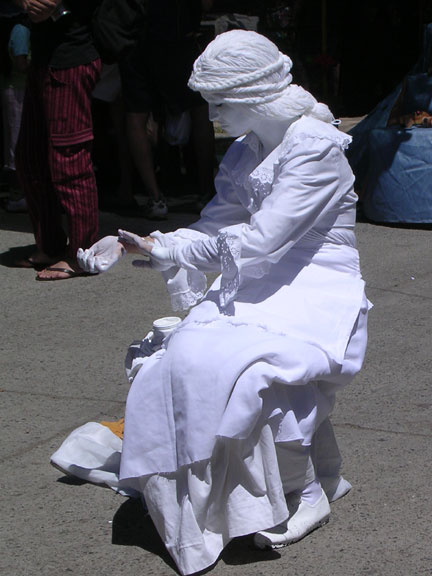 |
La Trochita

Friday, the 28th of January:
We had planned to visit Chile. The lake district and the island of Chiloe was just a half a day"s drive away. The border is almost two hours from Bariloche and we left in the midmorning. When we got the border, we were told that it was illegal for us to leave the country with an Argentinean registered car. Now they let all Argentineans to cross with their cars and this was my legally owned and registered car. Now I could have run the boarder, but for sure I would have been arrested and the car seized when I came back. To say I was outraged by this law which stole my property rights would be an understatement. But no amount of cajoling would persuade them to give the documents that I needed. We returned to Bariloche. I went to the customs office there, but once again I got nowhere. I went to the federal courthouse and was able to talk to a judge"s assistant and a federal prosecutor. I was also led to believe that I would not have the same problem going into the other neighboring countries. The problem was the long-standing Chile-Argentina rivalry and disaffection. How I get caught in the middle of this insanity is beyond me, still it happened. And of course, nothing could be done that day. Had I know of the problem before that day I could have sued in the federal court to have my property rights restored. We will do this when we return in BA. It seems that the agency that governs customs also collects all the taxes and runs the social security program here. To say that it is a giant and unwieldy bureaucracy would be an understatement. Inefficiency and irrational laws are fact of life here. In my mind the only thing that could be worse than this is the populace that allows it to continue without any challenges.
So we headed south, back to El Bolson, late in the afternoon. The one good thing about El Bolson and all the towns south of here is the cheap gas. In the north it cost about 65 cents per liter or about $2.40 USD per gallon. In the south it cost only 40 cents a liter or about $1.50 per gallon.
Saturday, 29th of January:
We drove south toward Esquel. About half way, in the middle of nowhere, is the Museo Leleque, which is a history museum sponsored by the Benetton Group. It was a nice place to stop and get a sense of the area and its history. This is the area where Butch Cassady and the Sundance Kid lived in when they left the states, and they had some good information on the pair. From here we drove to Esquel. It is another small mountain town with a lake. It is also famous for its small-gauge train, La Trochita. The trains were built about 1920 and I believe that their only function now is as a tourist attraction. As we left Esquel we saw the train a coming down the track and we stopped to photograph it. Next we set out to cross the middle of Patagonia and the Chubut province. There is not much here except a beautiful desert landscape, similar to what you might see in the western part of the USA. When we got to the Chubut River it was especially picturesque. After driving all day we stopped in the Welch village of Gaimen. We stayed at the Hosteria Ty Gwyn. It was late so we did not look around the town much. We found a nice restaurant, ate and then retired to our room.
Painted Desert 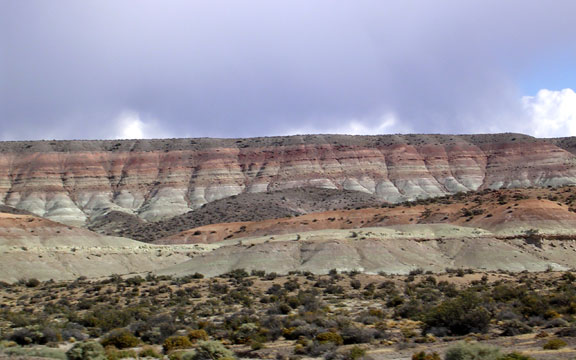 |
Chubut Rocks 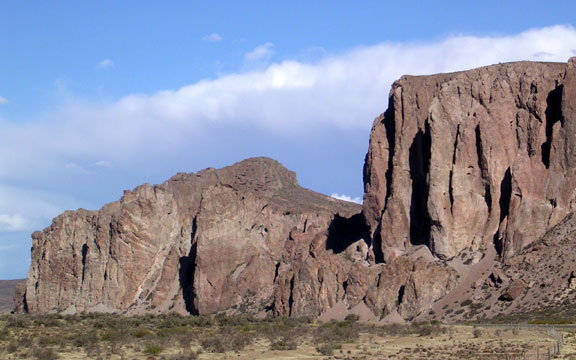 |
Puerto Madryn
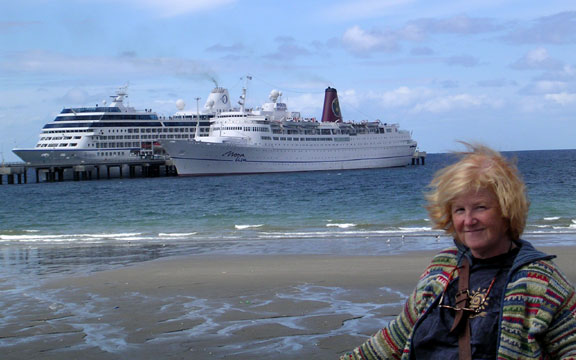
Sunday, 30th of January:
After a nice breakfast we drove around the town. There was not much to it, but there are some sights. About an hour away is Trelew. We stopped at the Museo Paleontologico de Trelew, which is dedicatied to the large number of dinosaur bones found in Chubut and the rest of Argentina. This area is a treasure trove for dinosaur hunters with fossils abounding everywhere. During our visit it was pouring outside, so it was the perfect thing to do. After this we drove to Puerto Madryn. We walked around the port area before we found a place to stay. Then we headed back to the port area to get some empanadas and pizza.
Monday, 31st of January:
Almost the entire day was spent visiting the dusty Peninsula Valdes. It is a famous reserve with many animals along the Atlantic. It is a desert and most of the roads are gravel we drove for more than a hundred miles looking for guanacos, sea cows, seals and penguins. We only saw seals and guanacos. We may come back in the fall to see the right whales that live in the Gulf of San Jose most of the year. The road dust filled the car. Our hair felt like it was encased in clay, it dried out our skin, and filled our noses. We were done with our drive in the mid afternoon. We drove north a couple of hours to La Grutas. Las Grutas is a seaside resort. Given how cold it had been and was, I was surprised to see so many people there. In any case we just spent the night.
Guanaco 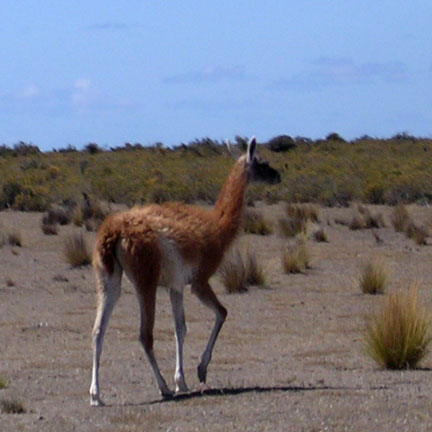 |
Seal Bull 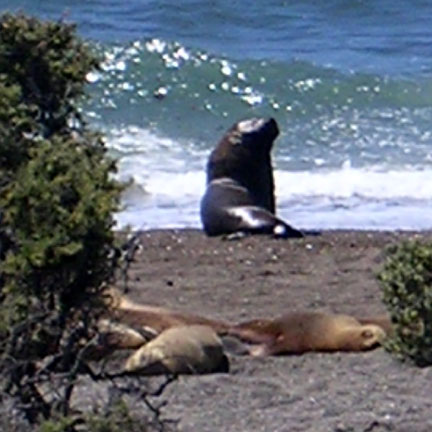 |
Guanacos on the Run
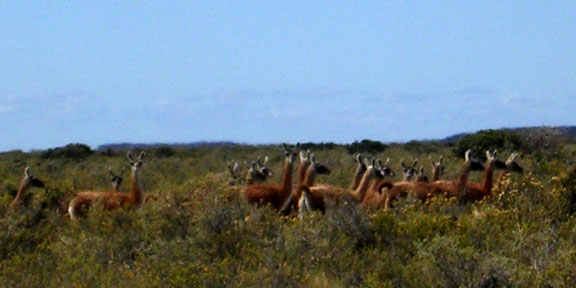
Tuesday, the first day of February:
We headed north. The desert disappeared and wonderful grasslands, cornfields, and sunflowers returned to our purview. I really like this part of Argentina. Towns are far apart, but occasionally the farms seemed to be closer together. After driving all day we returned to our house in Buenos Aires. It was good to be back in our own bed. I was so tired. All the driving wore me out. I had driven more than 4200 kilometers in the previous ten days.
When we got back, there was a note that we had received a certified letter. The post office that had it was a mile away, so we dove over on Wednesday to pick it up. I waited in line 20 minutes to get the certified letter. The letter said that there was a package waiting for us downtown. Why we could not pick it up at the local branch seemed odd to me, but we headed downtown. We had planned to go there anyway to visit MALBA. Again I waited a half an hour only to be told that no I could not get my package because the only acceptable ID was an original passport - not my proffered driver"s license and not my copy of my passport and not my car registration. Such is the typical bureaucratic morass of Argentina and probably most of the rest of the world.
I love MALBA. It is a modern art museum of Latin American artists. Its exhibits are pretty good and often very amusing. I had been there before and I will surely visit again.
The next day, we returned to the downtown post office on the train. Again we waited and waited and waited. Eventually we met with a customs agent, who began opening the package. "Wait a minute; why are you opening this?" I said in my broken Spanish. His reply was that he was a customs agent. "So this is just some gifts from my son?" Betty said something about paying. Perhaps he thought she was offering a bribe. Suddenly he handed me the package and shook our hands. Surprised and gratified, we quickly scurried away. We took the train back to our place. We had spent nearly a half-a-day picking up our package. Once again we witnessed the total disrespect that the government has for its citizens, because the Argentineans were subject to the same crazy system. I should mention that the post office used a little basket on a wire to send the paper work upstairs where they would fetch our package. What a technological powerhouse!
The package contained some nice gifts from Dain: a couple of puzzles, a room perfumer (something very cool that I had never seen before), Betty"s Vonage box and a wireless router for me. Now we have a US phone number and cordless phones. This technology is just unbelievable. Some of you will want to check it out.
Well, that is it for now. Next time we will report on our first visitors.
Valdes Beach Goers
